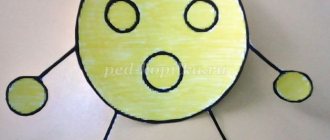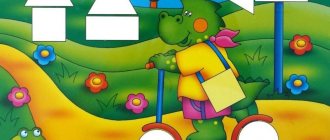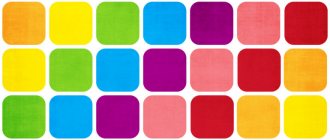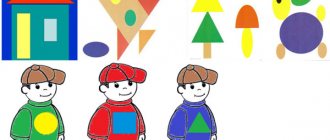How to play: We bring large and small cubes by car.
— "Transforming"
We became builders and built tower houses: one house for a bear from large cubes, and another for a bunny from small cubes.
It is advisable to beat the “bear”
and
“hare”
with the help of a poem:
“The bear has a big house (we spread our hands,
And the hare is small (put your palms )
.
Our bear went home (we depict the gait of a bear,
And behind him comes the bunny (jumping)
».
Option 2. Purpose: to consolidate knowledge about the size of objects , to introduce the concepts of “tall”
,
“low”
,
“equal in height”
.
Material: toy car, cubes of the same size.
Progress of the game: An adult reads a poem:
“A doll is sitting on a cart, selling nuts.”
and takes out a large doll.
- Look, a doll came to us and brought nuts. While the child is looking at the nuts, a small doll appears.
The adult encourages the child to compare the dolls by size and then divide the nuts: the large doll gets large walnuts, and the small doll gets small hazelnuts. Next, you can count the nuts and roll them with your palms to develop fine motor skills.
"Water in glasses"
Purpose: to form the concept of maintaining the volume of liquid in glasses.
Material: two glasses of the same shape , one glass is taller and narrower than the first two.
Progress of the game. Two glasses of the same shape , located at different distances from the child, but with equal amounts of water (which the child did not know about)
.Questions for children:
-What do you see on the table?
- Look and tell me where there is more water?
Children often get confused because the glasses are at different distances from the child and therefore it seems that the amount of water in the glasses is different.
The teacher pours water from one glass into another glass of a different size (in front of the child)
.
During the lesson, the teacher forms in the child the concept that the volume of liquid in glasses will not change regardless of the shape of the glass . Questions for the child:
- Look and tell me where there is more water?
- Tell me, is it equal water?
- Yes, equally. You didn’t pour the water out, but simply poured it into this glass. It is taller and narrower, and it seems that there is more water in it.
"Christmas trees"
Goal: to develop the ability to compare two objects using a third .
Materials: two Christmas trees glued to a sheet, pencil, scissors, measure - a strip of colored paper.
How to play: We bring cubes of the same size by car.
An adult builds two towers of equal height and tells the child that the towers are the same. Then he removes or adds details and tells again,
that now the towers are different, one high, like dad (like a tree, like a lamppost, and the other low, like a son (like a daughter, like a flower)
.
Important: make a visual comparison of the height of objects .
Encourage children to build low, high and identical towers.
"Let's feed the dolls"
Goal: learn to sort objects by size .
Material: large and small dolls, walnuts and hazelnuts.
Prepare large and small dolls, walnuts and hazelnuts in advance. Important: toys must be three-dimensional, flat pictures are not suitable .
Progress of the game:
In front of the child are two bricks of equal length, located exactly one below the other.
— How to find out which brick is longer?
- You need to measure them (measures the first brick)
.
— Merochka tried it on 2 times. The yardstick will also measure this brick 2 times, because they are the same. (Then I move one of the bricks to the side)
.
The teacher is faced with the task of making children understand that no matter how far objects are from each other, their length does not change. If the child finds it difficult to answer, then you can invite him to mark each measurement on the work card using a counter .
- Now which brick is longer?
- This and this brick are the same, because the measurement showed that
this brick and this brick are the same in length.
“How Grandma and Grandpa Got Lost in the Forest”
Goal: to form the concept of maintaining distance between objects .
Material: two fairy-tale characters, counting sticks, toy tree.
Progress of the game: On the table, at some distance from each other, there are two fairy-tale characters - grandmother and grandfather. The teacher asks the child a question:
- How far do you think grandparents are from each other?
— Is it possible to measure this distance?
- How will you do it?
The child measures the distance with a yardstick or stick.
— There are four measurements between grandparents.
— One day a tree grew between them (I put a tree between the characters)
.
- Do you think grandparents are just as far apart from each other? If the child finds it difficult to answer, then you can invite him to measure the distance between the characters again.
- Yes, the same. I measured without wood, there were four measurements and now there are four measurements. We did not move or move grandparents. Thus, the child better understands that the distance remains, even if there is an object .
“Where is more?”
Goal: to form the concept of maintaining inequality in the amount of a substance, regardless of the shape of the vessel .
Material: two glass glasses of the same shape , in which unequal amounts of water are poured, one narrow glass.
Progress of the game: On the table are two glass glasses of the same shape , in which unequal amounts of water are poured.
We invite the child to take any of the cups (we take the second one for ourselves)
.
- Who do you think has more water, you or me?
- I have more, and you have less.
I pour water from my glass into a narrow glass. The water level becomes higher than in the child's glass, although the volume of water is less.
- Who has more water now?
- I have. Your glass is thin and large and the water has risen. - I have more water. - Why do you think you have more water?
If the child finds it difficult, offer to pour the water into the glass where it was. In this case, the child will see that inequality
amount of water preserved, regardless of the shape of the vessel .
- I understand , you need to pour your water, where it was and then it will be clear
that I have more water.
“Where is the tea?”
Goal: to form the concept of preserving the whole when dividing it into parts.
Material: six cups, four are filled with water, and two cups are empty. Work card , two types of chips.
How to play: There are cups on the table with water in them, and some cups are empty.
- Tell me how many cups are there in total?
- There are six cups in total.
- What is more: just cups or cups of water?
— More cups of water.
“Listen again to what I’m asking you.”
- What are the most cups or cups of water? During this period of learning, children face some difficulties and some children (to the question: what are more: just cups or cups of water)
give the wrong answer.
If the child finds it difficult, then you should invite him to put marks on the work map .
After which the child counts, compares the marks and answers the question posed by the teacher. — Put as many marks on the first row of the card as there are all the cups. — On the second row of the map , put as many marks as there are cups of water.
- Where are there more marks - at the top or at the bottom?
— Top marks, what are they telling you?
- About cups, about all cups.
— Are there marks on the bottom row that remind you of what they’re talking about?
— About cups of water.
- What more?
- All the cups, but fewer cups of water.
"Heavy, light"
Goal: to develop the ability to compare two objects : heavy, light.
Material: 2 small bags. One contains wooden figures: a ball, a cube and a cylinder, the other contains 3 soft toys.
Progress of the game: children stand in a circle, the teacher invites the children to “ride the train”
.
- Turn behind each other, let's go.
The train is here, here,
Train friend - friend
In the morning guys
Takes him to kindergarten.
Children with a teacher “follow each other and see 2 bags. One contains wooden figures: a ball, a cube and a cylinder, the other contains 3 soft toys.
- Stop! There are some bags lying around. (Children lift the bags.)
— One bag is heavy, the other is light.
- Which bag should we open? (Children open the heavy bag, then the light one.)
- Pick up one toy first, then the other. Which one is easier?
— Are the toys the same weight? (Children express their assumptions , the teacher leads them to the fact that the toys are different in weight.)
- Place heavy toys on the right shelf, and light ones on the left.
"Let's water the flower"
Purpose of the game: to give an idea of the invariability of the volume of liquid depending on the shape and size of the vessel .
Material: 2 transparent jars of different shapes and sizes with water , 2 jars of the same shape and size .
How to play: There are 2 cans of different shapes and sizes . In them
the same amount of water, but the children think there is more water in one jar.
— We have 2 cans of water. Let's water the big flower, it needs a lot of water. Which jar will we water from? (The teacher deliberately confuses the children by hinting that there is more water in one can.)
- How can you check which jar has more water and which one has less? I don't know. (Children come to the conclusion that they need to take jars of the same shape and size .)
- Here are two identical cans. We pour water into them. And what? Children see that there was the same amount of water in both vessels. The teacher pours the water several times, changing the vessels. Children come to the conclusion that the volume of liquid does not depend on the shape and size of the vessel .
"Juice for Cheburashka"
Goal: to continue to form ideas about the invariability of the volume of liquid depending on the shape and size of the vessel .
Materials: Gena and Cheburashka crocodile toys, 4 transparent vessels of different shapes and sizes , 2 identical jars, juice (colored water)
Progress of the game: Cheburashka and the crocodile Gena came to visit and brought juice with them. Children approach the table on which there are toys, 2 vessels of different shapes and sizes with “juice”
. It seems that Cheburashka has less juice, and Gena has more.
— Cheburashka and Gene were poured juice into different jars. Who has more juice? Less?
- How to determine ? The teacher pours the juice into other vessels, different in shape and size . Now it seems that Cheburashka has more juice.
- Now Cheburashka has more juice. This is true? Children's thoughts. The teacher pours the juice into jars of the same shape and size , and the children see that there is the same amount of juice.
- Why did it seem to us that there was more juice in one jar and less in the other? - How to establish the truth?
"Water for a Flower"
Goal: to reinforce the idea that the volume of liquid is constant depending on the shape and size of the vessel .
Material: vases – low with a wide neck and high with a narrow neck.
How to play: There are vases on the table - a low one with a wide neck and a tall one with a narrow neck. There is water in a low vase.
— We need to put a flower in a vase with water. But there is not enough water here. The flower is not enough. I will pour water from this vase into another. (The teacher pours the water into another vase.)
“You can immediately see that there is a lot of water.” Now you can put up a flower. Guys, is there more water?
(Children, with the help of the teacher, establish the truth about the constant volume of water.)
- That’s right, because we didn’t remove or add water, we just poured it into another vase.
"Where is more"
Goal: to continue to reinforce the idea that the volume of liquid is constant depending on the shape and size of the vessel .
Material: 2 transparent jars of different shapes (a square is glued on one jar and a rectangle on the other), 2 identical glasses of water.
How to play: There are 2 transparent jars of different shapes and 2 identical glasses of water on the table. A square is glued to one jar, a rectangle to the other. The same figures are on the glasses.
—Which jar should we pour water into first? The teacher pours water from a glass with a rectangle into a jar with a rectangle - it is lower, wider. Then he pours water from a glass with a square into a jar with a square - it is tall and narrow.
—Which jar has more water? Children express their guesses . The teacher and the children pour the water back into the glasses and do the pouring in reverse: from a glass with a rectangle into a jar with a square, from a glass with a square into a jar with a rectangle.
—Which jar has more water? (Children express their assumptions and, with the help of the teacher, come to the conclusion that the amount of water does not depend on the shape and size of the vessel .)
"Building a house"
Goal: ability to determine the relationship of five objects in height .
Material: 5 columns of different heights (Kuiser sticks)
for everyone, a toy house.
Progress of the game: children sit at tables on which there are 5 columns of different heights (Kuiser sticks)
for everyone.
— We’ll take some logs with you
We will build a new house.
— And to build a new house, you must first correctly arrange all the logs (columns)
.
Place them in a row, starting with the tallest one. Children place logs (columns)
in a row. One child does this on the teacher’s table.
— How did you place the logs to build the house? (High, low, lower, even lower, lowest.)
- Well done, the logs have been sorted, now the builders can build a house quickly. The teacher places a finished house - a toy - on the table. You can play with this house, bring to it by car only those toys that will fit into it in size and height. Toys for the house can be selected using measurements, by application.
"Three Bears"
Goal: To consolidate the ability to differentiate objects by size ,
correlate objects according to this criterion .
Material: three toy bears, three sets of doll dishes of different sizes .







